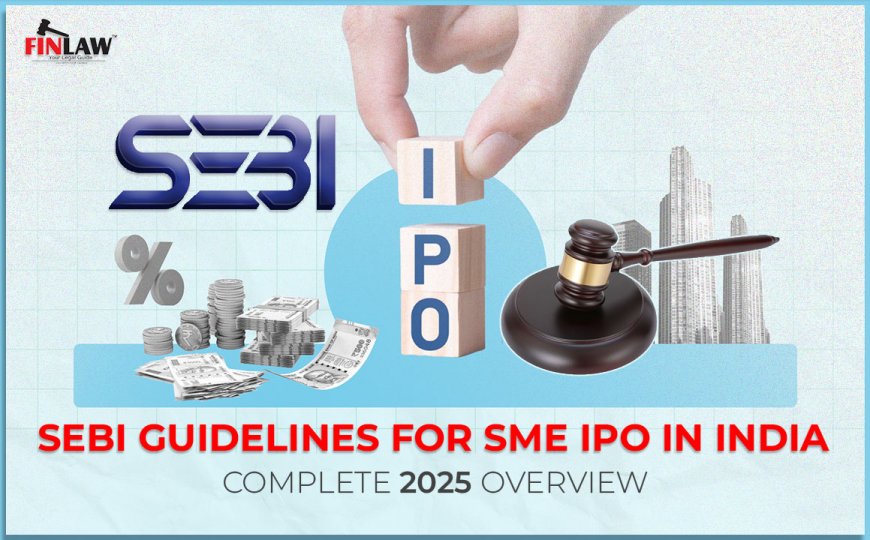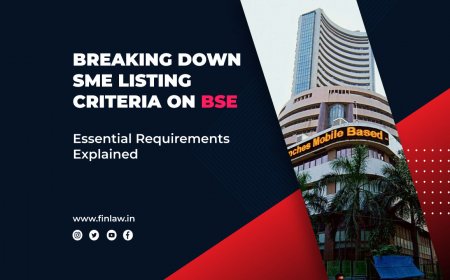SEBI Guidelines for SME IPO in India: Complete 2025 Overview
Explore SEBI guidelines for SME IPO in India (2025) including eligibility, process, benefits, and recent updates for startups and small businesses.

India's dynamic startup ecosystem and the rise of small and medium enterprises (SMEs) have led to an increasing number of businesses exploring the public markets. To facilitate this, the Securities and Exchange Board of India (SEBI) has created a dedicated framework for SME IPOs. The "SEBI guidelines for SME IPO" offer a simplified route for SMEs to access capital markets while maintaining investor confidence and regulatory oversight. In this 2025 overview, we break down everything entrepreneurs, investors, and stakeholders need to know about SEBI's SME IPO norms in India.
What is an SME IPO?
An SME IPO (Small and Medium Enterprise Initial Public Offering) allows smaller businesses to raise equity capital by listing on a stock exchange. Unlike mainboard IPOs, SME IPOs in India cater specifically to smaller enterprises and have relaxed eligibility criteria and compliance requirements. In India, the SME platforms of BSE (BSE SME) and NSE (NSE Emerge) provide this facility under the SEBI guidelines for SME IPO.
Why SEBI Introduced SME IPO Guidelines
SMEs often struggle to raise funds through traditional channels. Recognizing this gap, SEBI introduced SME IPO guidelines in 2012 to promote inclusivity in capital markets. The guidelines aim to:
-
Provide SMEs with access to equity capital.
-
Offer investors a diversified investment avenue.
-
Reduce over-dependence on debt financing for SMEs.
-
Enhance transparency and corporate governance in the SME sector.
Eligibility Criteria for SME IPO under SEBI Guidelines (2025 Update)
To file for an SME IPO in India, a company must meet the following SEBI-specified SME IPO conditions:
-
Post-Issue Paid-Up Capital: The post-issue paid-up capital should not exceed Rs. 25 crores.
-
Track Record: The company must have a minimum of 3 years of operational track record.
-
Net Worth and Tangible Assets:
-
Net worth of at least Rs. 1.5 crore.
-
Tangible assets worth Rs. 3 crore, out of which at least 50% should be held in India.
-
Profitability:
-
Positive cash accruals from operations for at least 2 out of 3 preceding financial years.
-
Positive net worth.
-
Dematerialization: The entire shareholding of the promoters must be in dematerialized form.
-
No Default: No defaults in repayment of loans to banks or NBFCs in the last 3 years.
SEBI Filing and Listing Process for SME IPO
-
Appointment of Merchant Banker:
-
SEBI mandates that the issuer appoint a SEBI-registered Merchant Banker as the lead manager.
-
Due Diligence and Draft Prospectus:
-
The Merchant Banker conducts due diligence and prepares the Draft Prospectus.
-
The Draft Prospectus is submitted to the Exchange, not SEBI, for review, as per SEBI guidelines for SME IPO.
-
In-Principle Approval:
-
The Exchange grants in-principle approval after examining the prospectus and compliance documents.
-
Public Offer and Allotment:
-
Shares are offered to the public.
-
Minimum application size is Rs. 1 lakh.
-
Allotment is done via the fixed price or book-building method.
-
Listing and Trading:
-
Once allotment is complete, the shares are listed on the SME Platform of NSE or BSE.
Lock-in Periods and Promoter Contributions
-
Promoter’s Contribution: Minimum of 20% of post-issue capital must be contributed by promoters.
-
Lock-in Period: Promoter’s contribution is locked-in for a minimum of 3 years from the date of allotment as mandated by SEBI guidelines for SME IPO.
Market Making Requirements
To provide liquidity and price stability, SEBI SME IPO regulations mandate market making for at least 3 years from the date of listing. The Market Maker:
-
Provides two-way quotes.
-
Ensures liquidity in the stock.
-
Cannot hold more than 5% of the issue size at any given time.
Migration to Mainboard
After successful listing and performance on the SME platform, companies can migrate to the mainboard, subject to the following conditions:
-
Minimum paid-up capital of Rs. 10 crore.
-
Listing on SME Platform for at least 3 years.
-
Shareholder approval through a special resolution, as laid down in SEBI SME IPO migration guidelines.
Benefits of SME IPO for Indian Businesses
-
Access to Growth Capital: Enables long-term funding without increasing debt burden.
-
Brand Visibility: Public listing enhances company reputation and stakeholder trust.
-
Valuation Benchmark: Provides a fair market valuation.
-
Exit Route: Offers promoters and early investors an exit opportunity.
-
M&A Opportunities: Improves attractiveness for mergers and acquisitions.
Recent Trends and SEBI Amendments in 2025
As of 2025, SEBI has introduced several refinements to further streamline the SME IPO process in India:
-
Simplified disclosure norms for businesses with clean financial track records.
-
Integration with the online SCORES platform for faster investor grievance redressal.
-
Incentives for listing green tech and women-led SMEs.
-
Digital IPO application process for ease of access for retail investors.
Challenges SMEs Face Despite SEBI Guidelines
While SEBI guidelines for SME IPO have simplified the process, SMEs still face challenges such as:
-
High compliance and listing costs.
-
Difficulty in meeting market making obligations.
-
Limited investor awareness.
-
Valuation pressures during the IPO stage.
Conclusion
SEBI guidelines for SME IPO have opened a new avenue of growth for Indian startups and MSMEs. With evolving regulations, increasing investor participation, and digital-first reforms, the SME IPO space is expected to grow rapidly in 2025. However, SMEs must prepare meticulously to meet eligibility norms, maintain transparency, and build investor confidence. For Indian entrepreneurs seeking scalability, an SME IPO could be the stepping stone to long-term success.
Frequently Asked Questions (FAQs)
1. Can a startup with no profits go for an SME IPO?
Yes, provided it meets net worth, asset, and cash accrual norms specified by SEBI guidelines for SME IPO.
2. What is the cost of an SME IPO in India?
Costs can range between Rs. 30 to 70 lakhs including legal, merchant banking, and compliance fees.
3. Is SEBI approval needed for SME IPO?
No, approval is granted by the stock exchange, not SEBI, though SEBI guidelines for SME IPO must be followed.
4. How long does it take to complete the SME IPO process?
Typically, 3 to 6 months from documentation to listing.
5. Can SMEs list directly on the mainboard?
Only if they meet the mainboard eligibility norms; otherwise, they must start with the SME platform under SEBI SME IPO guidelines.
What's Your Reaction?



















